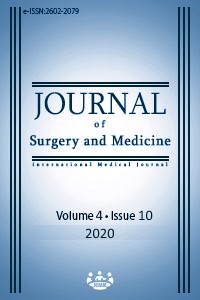Transcutaneous carbon dioxide monitoring during flexible bronchoscopy under sedation: A prospective observational study
Keywords:
bronchoscopy, hypoventilation, Transcutaneous carbon dioxide, propofol, moderate sedationAbstract
Aim: It is difficult to maintain the necessary depth of sedation during bronchoscopy, and hypoxemia, hypoventilation, and undesirable cardiovascular effects are often encountered. Transcutaneous carbon dioxide monitoring is a reliable means of detecting hypoventilation. The aim of this study was to determine the effects of transcutaneous carbon dioxide (tPCO₂) monitoring on the amount of propofol required for sedation and examine sedation-induced hypoventilation and other adverse events requiring intervention, such as stopping the procedure to ventilate during flexible bronchoscopy. Methods: This prospective observational study included 60 patients undergoing bronchoscopy who were administered propofol. Of these, 30 patients were observed with transcutaneous carbon dioxide, and 30 were observed without. Propofol was used for sedation in all patients and the amount of propofol was compared between the groups monitored and not monitored transcutaneously for carbon dioxide. The sedation level was determined with the subjective sedation scale of the group that was not monitored. Results: No significant differences were found between the groups in terms of propofol consumption or the number of patients who required airway interventions during the procedure (P>0.05 for both). In this observational study, the partial carbon dioxide pressure in arterial blood was measured with a transcutaneous carbon dioxide monitor, which is a non-invasive method, and the maximum carbon dioxide value measured in prolonged interventions was 85 mmHg. Hypoxia was not observed in patients who developed hypoventilation. Conclusions: Hypoventilation is inevitable during bronchoscopy. Transcutaneous carbon dioxide monitoring may be important for high-risk cardiovascular patients.
Downloads
References
Hong KS, Choi EY, Park DA, Park J. Safety and Efficacy of the Moderate Sedation During Flexible Bronchoscopic Procedure: A Systematic Review and Meta-Analysis of Randomized Controlled Trials. Medicine (Baltimore). 2015;40:e1459.
Poi PJ, Chuah SY, Srinivas P, Liam CK. Common fears of patients undergoing bronchoscopy. Eur Respir J. 1998;11:1147-9.
Stolz D, Chhajed PN, Leuppi JD, Brutsche M, Pflimlin E, Tamm M. Cough suppression during flexible bronchoscopy using combined sedation with midazolam and hydrocodone: a randomised, double blind, placebo controlled trial. Thorax. 2004;59:773-6.
Dreher M, Ekkernkamp E, Storre JH, Kabitz HJ, Windisch W. Sedation during flexible bronchoscopy in patients with pre existing respiratory failure: Midazolam versus Midazolam plus Alfentanil. Respiration. 2010;79:307-14.
Fruchter O, Tirosh M, Carmi U, Rosengarten D, Kramer MR. Prospective randomized trial of bispectral index monitoring of sedation depth during flexible bronchoscopy. Respiration. 2014;87:388-93.
Ramsay MA, Savege TM, Simpson BR, Goodwin R. Controlled sedation with alphaxalone-alphadolone. Br Med J. 1974;22:656-9. PubMed PMID:4835444; PubMed Central PMCID: PMC1613102.
Ishiwata T, Tsushima K, Terada J, Fujie M, Abe M, Ikari J, et al. Efficacy of End-Tidal Capnography Monitoring during Flexible Bronchoscopy in Nonintubated Patients under Sedation: A Randomized Controlled Study. Respiration. 2018;96:355-362. doi: 10.1159/000489888. Epub 2018 Jun 28 PubMed PMID: 29953986.
Aarrestad S, Tollefsen E, Kleiven AL, Qvarfort M, Janssens JP, Skjønsberg OH. Validity of transcutaneous PCO2 in monitoring chronic hypoventilation treated with non-invasive ventilation. Respir Med. 2016;112:112-8. doi: 10.1016/j.rmed.2016.01.017. Epub 2016 Jan 27. PubMed PMID: 26874895.
Lermuzeaux M, Meric H, Sauneuf B, Girard S, Normand H, Lofaso F et al. Superiority of transcutaneous CO2 over end-tidal CO2 measurement for monitoring respiratory failure in nonintubated patients: A pilot study. J Crit Care. 2016 Feb;31:150-6. doi: 10.1016/j.jcrc.2015.09.014. Epub 2015 Sep 25. PubMed PMID: 26463320.
Perel A. Nonanaesthesiologists should not be allowed to administer propofol for procedural sedation: a Consensus Statement of 21 European National Societies of Anaesthesia. Eur J Anaesthesiol 2011;28:580–4.
Kiely DG, Cargill RI, Lipworth BJ. Effects of hypercapnia on hemodynamic, inotropic, lusitropic, and electrophysiologic indices in humans. Chest. 1996;109:1215-21. PubMed PMID: 8625670.
Ali AH, Toba H, Sakiyama S, Yamamoto R, Takizawa H, Kenzaki K et al. Holter ECG monitoring of sympathovagal fluctuation during bronchoscopy. Clin Respir J. 2016;10:204‐10. doi: 10.1111/crj.12204
Kumar S, Nath A, Singh S, Bhatia T, Kapoor A. An unusual complication during bronchoscopy: hypotension, global ST segment elevation, and acute severe left ventricular systolic dysfunction. Respir Care. 2013;58:e111‐e115. doi: 10.4187/respcare.02318.
Li M, Liu Y, Wang H. Diagnosis and prognosis of myocardial infarction in a patient without obstructive coronary artery disease during bronchoscopy: a case study and literature review. BMC Cardiovasc Disord. 2020;20:185. Published 2020;21. doi: 10.1186/s12872-020-01458-5.
Chhajed PN, Rajasekaran R, Kaegi B, Chhajed TP, Pflimlin E, Leuppi J, et al. Measurement of combined oximetry and cutaneous capnography during flexible bronchoscopy. Eur Respir J. 2006 Aug;28:386-90. doi: 10.1183/09031936.06.00088005. Epub 2006 Apr 26. PMID: 16641122.
Carmi U, Kramer MR, Zemtzov D, Rosengarten D, Fruchter O. Propofol safety in bronchoscopy: prospective randomized trial using transcutaneous carbon dioxide tension monitoring. Respiration. 2011;82:515‐21. doi: 10.1159/000331506.
Evans EN, Ganeshalingam K, Ebden P. Changes in oxygen saturation and transcutaneous carbon dioxide and oxygen levels in patients undergoing fibreoptic bronchoscopy. Respir Med. 1998;92:739‐42. doi: 10.1016/s0954-6111(98)90005-1.
Lo YL, Lin TY, Fang YF, Wang TY, Chen HC, Chou CL, et al. Feasibility of bispectral index-guided propofol infusion for flexible bronchoscopy sedation: a randomized controlled trial. PLoS One. 2011;6:e27769. doi: 10.1371/journal.pone.0027769. Epub 2011 Nov 23. PubMed. PMID: 22132138; PubMed Central PMCID: PMC3223212.
Gaisl T, Bratton DJ, Heuss LT, et al. Sedation during bronchoscopy: data from a nationwide sedation and monitoring survey. BMC Pulm Med. 2016;16:113. Published 2016 Aug 5. doi: 10.1186/s12890-016-0275-4.
Downloads
- 344 760
Published
Issue
Section
How to Cite
License
Copyright (c) 2020 Ferda Yaman, Nesimi Günal
This work is licensed under a Creative Commons Attribution-NonCommercial-NoDerivatives 4.0 International License.
















